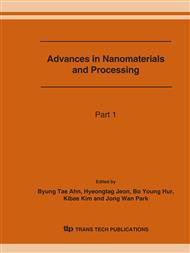p.475
p.479
p.483
p.487
p.491
p.495
p.499
p.503
p.507
Detection of Toxic Organophosphate Nerve Agents Using DBR Porous Silicon Chip
Abstract:
The efficient detection method based on nanostructured photonic DBR PSi has been developed for DMMP, which is a simulant for G-type nerve agents. The manufactured DBR PSi chip exhibits a sharp photonic band gap at 520 nm. The detection method involves the shift of DBR peak in reflectivity spectra under the exposure of vapors of analyte. Rapid detection has been achieved in few seconds, in situ, and observed by the red-shift of DBR peak resulted from the increase of refractive indices in DBR PSi. When DBR PSi chip is exposed to DMMP, TEP, and DEEP-saturated air, DBR peak in reflectivity is red shifted by 10 nm, 25 nm, and 10 nm, respectively. Real-time detection for the nerve gases indicates that the measurement is reversible. Detection limit of DMMP (1.5 ppm) using DBR PSi is 8.8 mg/m3 for 1 min.
Info:
Periodical:
Pages:
491-494
Citation:
Online since:
June 2007
Authors:
Keywords:
Price:
Сopyright:
© 2007 Trans Tech Publications Ltd. All Rights Reserved
Share:
Citation:


